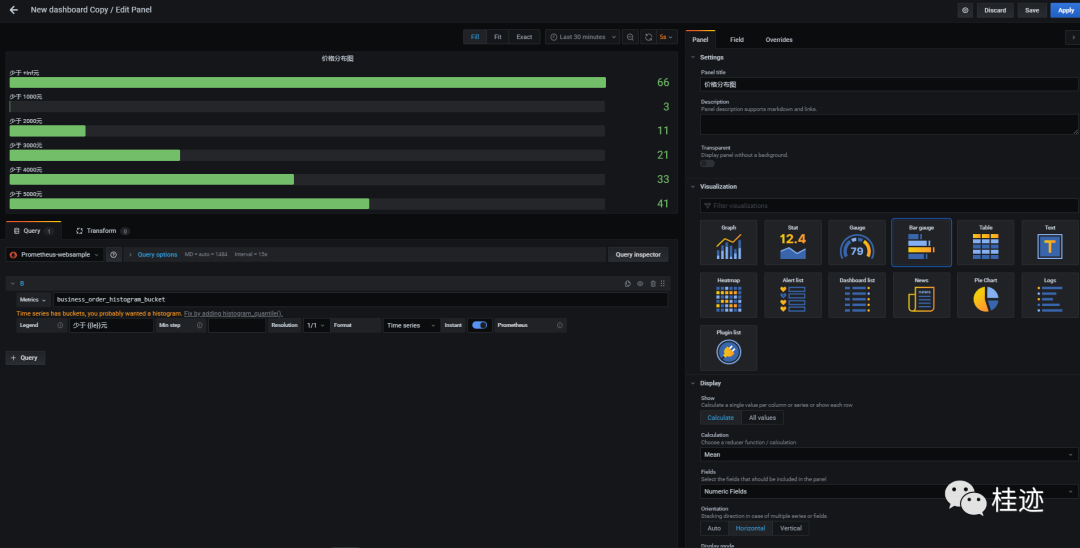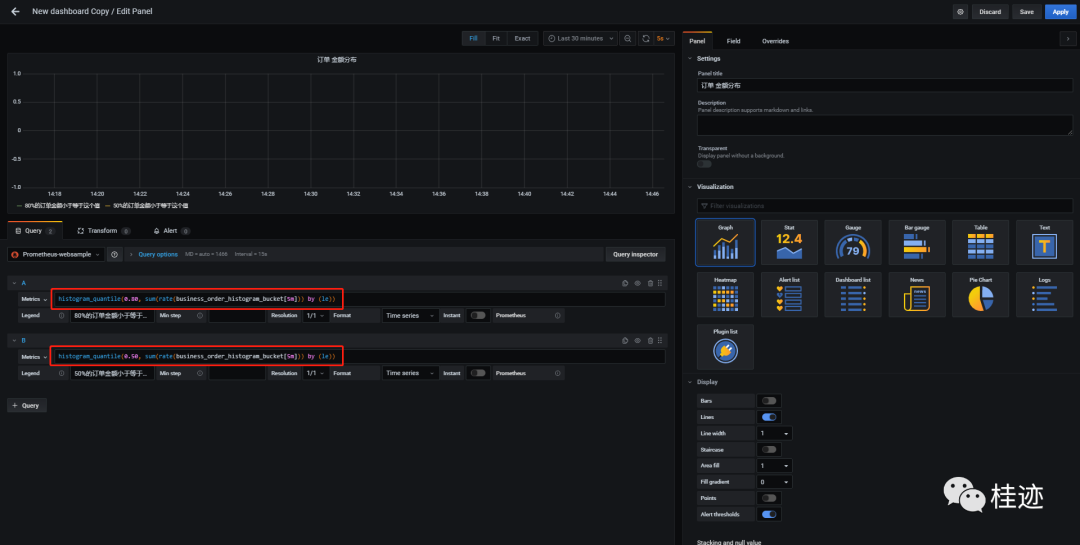asp.net core监控—引入Prometheus(四)
上一篇博文中说到Prometheus有四种指标类型:Counter(计数器)、Gauge(仪表盘)、Histogram(直方图)、Summary(摘要),并且我们做了一个Counter的Demo,接下来看看Histogram。
3、Histogram:直方图
直方图,维基百科的定义:是一种对数据分布情况的图形表示,是一种二维统计图表,它的两个坐标分别是统计样本和该样本对应的某个属性的度量,以长条图(bar)的形式具体表现。因为直方图的长度及宽度很适合用来表现数量上的变化,所以较容易解读差异小的数值。还是拿上一篇的Sample来说明,假如每个订单都有一个金额,在order时在返回值{result=true,data=1000}的data属性中返回,这里,我们就可以用直方图来收集这个金额,由于订单的金额不一样,我们就可以用直方图来展示一定范围金额内订单的数据,监控出一定金额范围内的订单比例了。就是说在一定数量的订单里,少于1000元的有多少个订单,少于2000元有多少个订单,少于3000元的有多少个订单……
首先,我们得修改BusinessController中Order Action的业务逻辑,把订单金额作为返回值:
[HttpGet("/order")]
public IActionResult Order(string orderno)
{
try
{
_logger.LogInformation("下单");
//返回订单金额
var random = new Random();
return new JsonResult(new { Result = true, data = random.Next(1, 8000) });
}
catch (Exception exc)
{
_logger.LogCritical(exc, exc.Message);
return new JsonResult(new
{
Result = false,
Message = exc.Message
});
}
}
这里的金额为了方便demo,是随机生成一个1到8000的随机数。
需要在MetricsHub.cs中添加Histogram类型的指标收集集合:
using Prometheus;
using System.Collections.Generic;
namespace PrometheusSample.Middlewares
{
public class MetricsHub
{
private static Dictionary<string, Counter> _counterDictionary = new Dictionary<string, Counter>();
private static Dictionary<string, Dictionary<string, Gauge>> _gaugeDictionary = new Dictionary<string, Dictionary<string, Gauge>>();
private static Dictionary<string, Histogram> _histogramDictionary = new Dictionary<string, Histogram>();
public Counter GetCounter(string key)
{
if (_counterDictionary.ContainsKey(key))
{
return _counterDictionary[key];
}
else
{
return null;
}
}
public Dictionary<string, Gauge> GetGauge(string key)
{
if (_gaugeDictionary.ContainsKey(key))
{
return _gaugeDictionary[key];
}
else
{
return null;
}
}
public Histogram GetHistogram(string key)
{
if (_histogramDictionary.ContainsKey(key))
{
return _histogramDictionary[key];
}
else
{
return null;
}
}
public void AddCounter(string key, Counter counter)
{
_counterDictionary.Add(key, counter);
}
public void AddGauge(string key, Dictionary<string, Gauge> gauges)
{
_gaugeDictionary.Add(key, gauges);
}
public void AddHistogram(string key, Histogram histogram)
{
_histogramDictionary.Add(key, histogram);
}
}
}
接下来就要在BusinessMetricsMiddleware的中间件中添加处理Histogram指标的代码了:
using Microsoft.AspNetCore.Http;
using PrometheusSample.Models;
using System.IO;
using System.Threading.Tasks;
namespace PrometheusSample.Middlewares
{
/// <summary>
/// 请求记录中间件
/// </summary>
public class BusinessMetricsMiddleware
{
private readonly RequestDelegate _next;
public BusinessMetricsMiddleware(RequestDelegate next)
{
_next = next;
}
public async Task InvokeAsync(HttpContext context, MetricsHub metricsHub)
{
var originalBody = context.Response.Body;
try
{
using (var memStream = new MemoryStream())
{
//从管理返回的Response中取出返回数据,根据返回值进行监控指标计数
context.Response.Body = memStream;
await _next(context);
memStream.Position = 0;
string responseBody = new StreamReader(memStream).ReadToEnd();
memStream.Position = 0;
await memStream.CopyToAsync(originalBody);
if (metricsHub.GetCounter(context.Request.Path) != null || metricsHub.GetGauge(context.Request.Path) != null)
{
//这里约定所有action返回值是一个APIResult类型
var result = System.Text.Json.JsonSerializer.Deserialize<APIResult>(responseBody, new System.Text.Json.JsonSerializerOptions { PropertyNameCaseInsensitive = true });
if (result != null && result.Result)
{
//获取到Counter
var counter = metricsHub.GetCounter(context.Request.Path);
if (counter != null)
{
//计数
counter.Inc();
}
var gauges = metricsHub.GetGauge(context.Request.Path);
if (gauges != null)
{
//存在增加指标+就Inc
if (gauges.ContainsKey("+"))
{
gauges["+"].Inc();
}
//存在减少指标-就Dec
if (gauges.ContainsKey("-"))
{
gauges["-"].Dec();
}
}
var histogram = metricsHub.GetHistogram(context.Request.Path);
if (histogram != null)
{
var parseResult = int.TryParse(result.Data.ToString(), out int i);
if (parseResult)
{
histogram.Observe(i);
}
}
}
}
}
}
finally
{
context.Response.Body = originalBody;
}
}
}
}
再就是在Starsup中配置对应url的Histogram参数了:
using Microsoft.AspNetCore.Builder;
using Microsoft.AspNetCore.Hosting;
using Microsoft.Extensions.Configuration;
using Microsoft.Extensions.DependencyInjection;
using Microsoft.Extensions.Hosting;
using Microsoft.OpenApi.Models;
using Prometheus;
using PrometheusSample.Middlewares;
using PrometheusSample.Services;
using System.Collections.Generic;
namespace PrometheusSample
{
public class Startup
{
public Startup(IConfiguration configuration)
{
Configuration = configuration;
}
public IConfiguration Configuration { get; }
public void ConfigureServices(IServiceCollection services)
{
MetricsHandle(services);
services.AddScoped<IOrderService, OrderService>();
services.AddControllers();
services.AddSwaggerGen(c =>
{
c.SwaggerDoc("v1", new OpenApiInfo { Title = "PrometheusSample", Version = "v1" });
});
}
public void Configure(IApplicationBuilder app, IWebHostEnvironment env)
{
if (env.IsDevelopment())
{
app.UseDeveloperExceptionPage();
app.UseSwagger();
app.UseSwaggerUI(c => c.SwaggerEndpoint("/swagger/v1/swagger.json", "PrometheusSample v1"));
}
app.UseRouting();
//http请求的中间件
app.UseHttpMetrics();
app.UseAuthorization();
//自定义业务跟踪
app.UseBusinessMetrics();
app.UseEndpoints(endpoints =>
{
//映射监控地址为 /metrics
endpoints.MapMetrics();
endpoints.MapControllers();
});
}
/// <summary>
/// 处理监控事项
/// </summary>
/// <param name="services"></param>
void MetricsHandle(IServiceCollection services)
{
var metricsHub = new MetricsHub();
//counter
metricsHub.AddCounter("/register", Metrics.CreateCounter("business_register_user", "注册用户数。"));
metricsHub.AddCounter("/order", Metrics.CreateCounter("business_order_total", "下单总数。"));
metricsHub.AddCounter("/pay", Metrics.CreateCounter("business_pay_total", "支付总数。"));
metricsHub.AddCounter("/ship", Metrics.CreateCounter("business_ship_total", "发货总数。"));
//gauge
var orderGauge = Metrics.CreateGauge("business_order_count", "当前下单数量。");
var payGauge = Metrics.CreateGauge("business_pay_count", "当前支付数量。");
var shipGauge = Metrics.CreateGauge("business_ship_count", "当前发货数据。");
metricsHub.AddGauge("/order", new Dictionary<string, Gauge> {
{ "+", orderGauge}
});
metricsHub.AddGauge("/pay", new Dictionary<string, Gauge> {
{"-",orderGauge},
{"+",payGauge}
});
metricsHub.AddGauge("/ship", new Dictionary<string, Gauge> {
{"+",shipGauge},
{"-",payGauge}
});
//histogram
var orderHistogram = Metrics.CreateHistogram("business_order_histogram", "订单直方图。",
new HistogramConfiguration
{
Buckets = Histogram.LinearBuckets(start: 1000, width: 1000, count: 5)
});
metricsHub.AddHistogram("/order", orderHistogram);
services.AddSingleton(metricsHub);
}
}
}
Histogram.LinearBuckets(start: 1000, width: 1000, count: 5)是金额从1000开始,每1000为一个台阶,一共6个台阶:0~1000,1001~2000,2001~3000,3001~4000,4001~5000,还有一个是大于5000的。
最后一步,就是打开Grafana来配置展示图表了。
订单金额分布图

订单比例分布图

图中histogram_quantile(0.80, sum(rate(business_order_histogram_bucket[5m])) by (le))的意思是“80%的订单金额小于等于这个值”5分钟内的值。
最终展示结果:

聪明的你一定发现,这篇博文与上一篇如出一辙,是的,只是监控指标展示类型不同而以。






【推荐】国内首个AI IDE,深度理解中文开发场景,立即下载体验Trae
【推荐】编程新体验,更懂你的AI,立即体验豆包MarsCode编程助手
【推荐】抖音旗下AI助手豆包,你的智能百科全书,全免费不限次数
【推荐】轻量又高性能的 SSH 工具 IShell:AI 加持,快人一步
· 无需6万激活码!GitHub神秘组织3小时极速复刻Manus,手把手教你使用OpenManus搭建本
· C#/.NET/.NET Core优秀项目和框架2025年2月简报
· Manus爆火,是硬核还是营销?
· 终于写完轮子一部分:tcp代理 了,记录一下
· Qt个人项目总结 —— MySQL数据库查询与断言